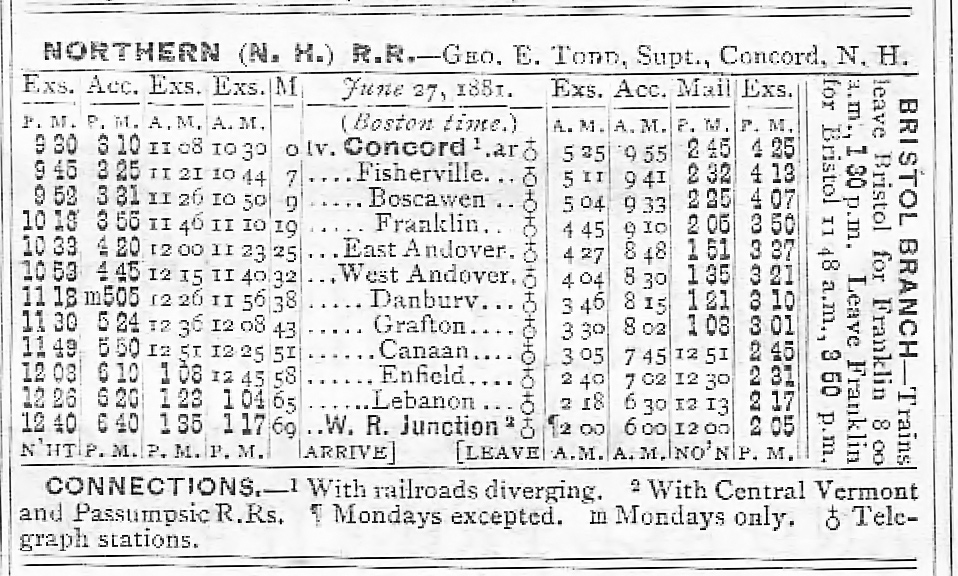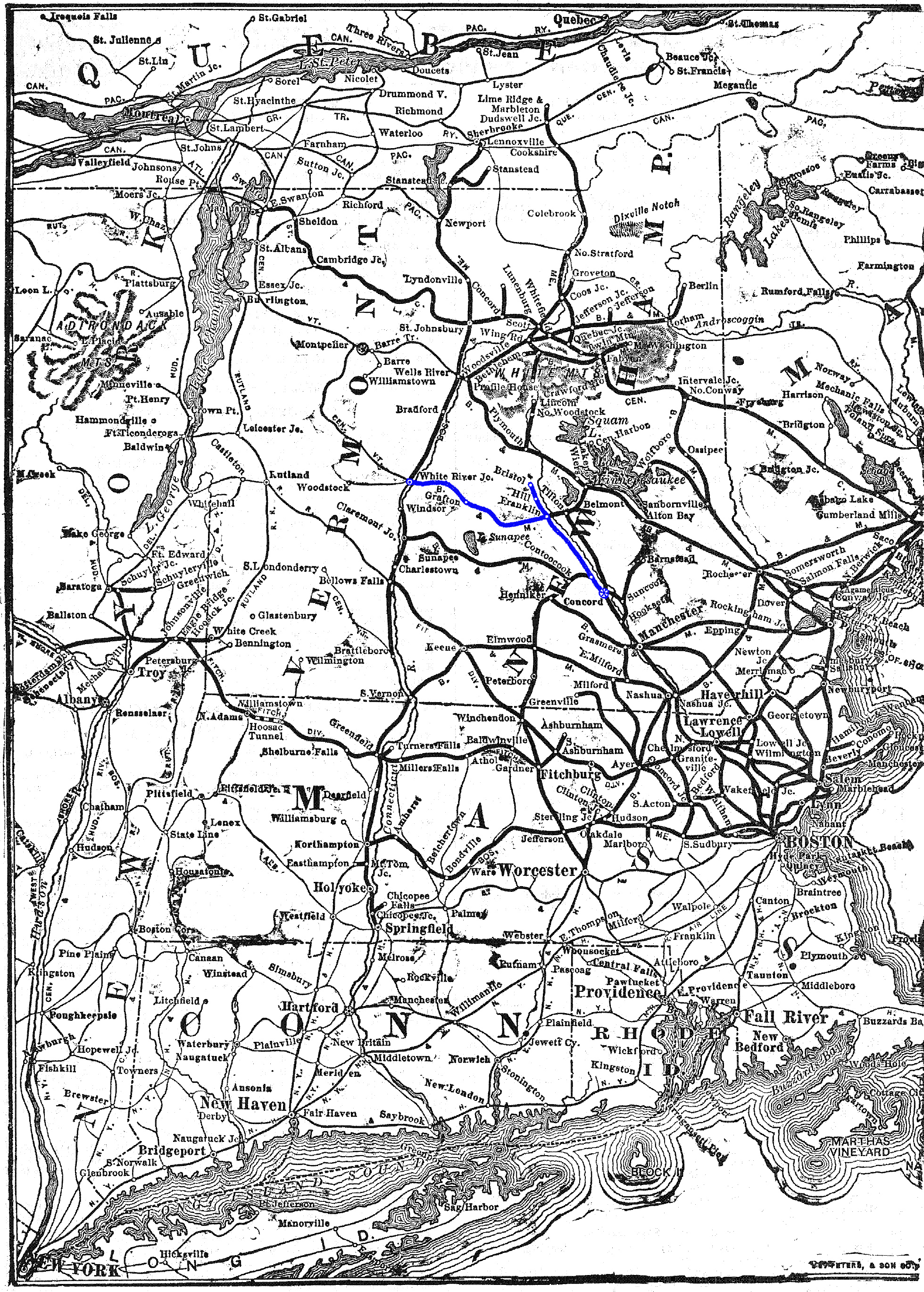Northern Railroad (NH): Map, Timetable, History
Published: February 11, 2025
By: Adam Burns
The Northern Railroad, once a vital artery in the development of New Hampshire and northern New England, is a testament to the transformative power of railroads in the 19th century.
From its inception to its eventual decline, the Northern played a pivotal role in shaping the economic and social landscape of the region.
It was eventually leased by the growing Boston & Maine in 1889 and played an important role within this large New England railroad's network, offering a direct connection to the Central Vermont Railway at White River Junction.
The route thrived until the post-World War II era; the final passenger service ceased on January 3, 1965. The line remained largely intact until the Guilford Transportation Industries era began, resulting in the abandonment of a 59-mile section from Boscawen to Lebanon in 1991.
After the early 1970s the line saw little use and was abandoned in stages over the years with the last remaining section abandoned in 2016. Today, part of the corridor is a rail trail.
Timetable (1881)
Early Years
The Northern Railroad received its charter in 1844 from the New Hampshire state legislature with a mandate to construct a route extending from Concord to a point on the Connecticut River.
Following its establishment in July, the railroad initiated groundbreaking activities on October 8, 1845. The initial segment, running from Concord to Franklin, commenced operations on December 28, 1846, under the management of the Concord Railroad.
By September 1, 1847, the Northern assumed control of the route extending to Canaan, and by November 17, the line had reached West Lebanon. In June 1848, an extension was constructed to White River Junction, situated across the Connecticut River in Vermont, thereby connecting with both the then-Vermont Central Railroad and the Connecticut and Passumpsic Rivers Railroad.
In July 1846, while the Northern was still under construction, the Franklin & Bristol Railroad received a charter to build a 13-mile line from Franklin on the Northern's main line to Bristol.
Prior to commencing operations on July 2, 1848, the company was leased to the Northern Railroad for a term of 100 years, effective from April that year, becoming its Bristol Branch.
Construction of the Northern Railroad progressed swiftly; by December 28, 1846, it had expanded to Franklin, and by November 17, 1847, it had reached Lebanon. Within a few months, work on the bridge over the Connecticut River was completed, finalizing the route to White River Junction. The Northern Railroad ultimately spanned approximately 70 miles.
During this period, the company also expanded through the acquisition of its sole branch by leasing, and subsequently assuming control of, the Franklin & Bristol in 1849. This small network connected Franklin to Bristol, New Hampshire.
Bruce Heald's book, "A History Of The Boston & Maine Railroad," notes that on July 24, 1889, the New Hampshire General Court authorized the Boston & Maine to formally lease the Northern Railroad.
System Map
Decline
Throughout the 20th century, the Northern Railroad continued to face diminished demand as automobiles and highways became the preferred means of transport for both passengers and freight.
By mid-century, sections of the railroad were gradually abandoned or repurposed, marking the end of an era. The last regular passenger service ran in the 1950s, and freight operations eventually ceased altogether.
Following 1973, usage of the line was sporadic, with one significant event being the passage of the Freedom Train in 1975. The line saw its final brief utilization in 1982 due to a derailment in Brattleboro, which obstructed the Boston and Maine route along the Connecticut River.
After the line was officially abandoned in 1992 by the Guilford Rail System—the successor to the Boston and Maine—New Hampshire state acquired 59 miles of the corridor in 1995, extending from Boscawen to Mile 140.00 in Lebanon, to establish the Northern Rail Trail.
In 1998, the state further purchased the remaining two miles up to White River Junction, which included the expansive Westboro Rail Yard, later leased to Claremont Concord Railroad and a local enterprise. In September 2016, a notice of intent was filed with the Surface Transportation Board to abandon the last 6.63 miles of the Northern Railroad main line stretching from Concord to Boscawen.
Today, much of the former Northern Railroad corridor has been transformed into recreational trails, such as the Northern Rail Trail, preserving its historic path for new generations to enjoy. These trails offer scenic vistas and a tangible connection to the region's past, serving as a testament to the railroad's enduring impact on New Hampshire.
Legacy
In conclusion, the Northern Railroad played an instrumental role in shaping the history and development of New Hampshire. Its journey from a pioneering transportation project to a cherished historical landmark reflects broader themes of progress, adaptation, and remembrance. The legacy of the Northern Railroad lives on, echoing the transformative power of railroads in the American story.
Recent Articles
-
North Carolina's - Murder Mystery - Dinner Train Rides
Dec 15, 25 10:37 AM
While there are currently no murder mystery dinner trains in the Tarheel State the Burgaw Depot does host a murder mystery dinner experience in September! -
North Carolina's 'Wine Tasting' Train Rides
Dec 14, 25 07:31 PM
A noteworthy way to explore North Carolina's beauty is by hopping aboard the Great Smoky Mountains Railroad and sipping fine wine! -
Nevada's 'Wine Tasting' Train Rides
Dec 14, 25 07:20 PM
While it may not be the first place that comes to mind when you think of wine, you can sip this delight by train in Nevada at the Nevada Northern Railway.





